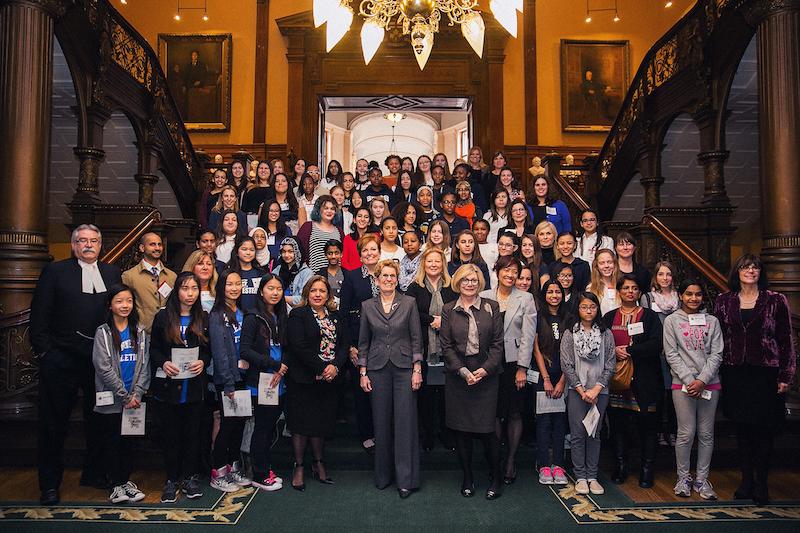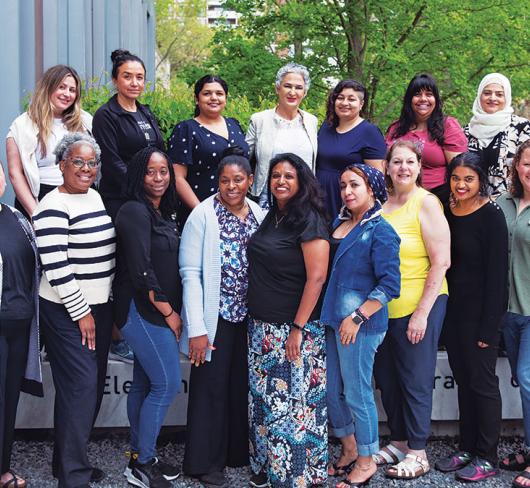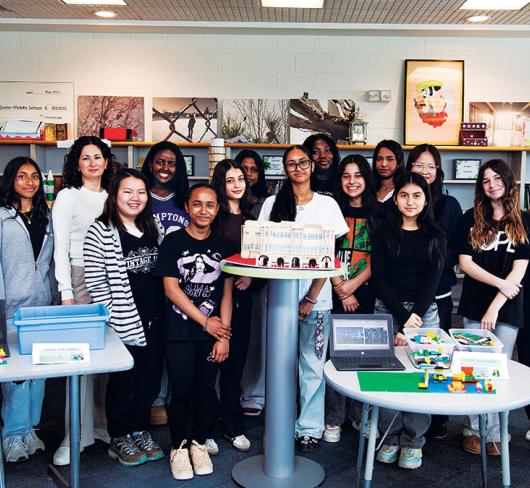
Girls' Government: Empowering Young Women to be Change Makers
In early March 2016, I learned about a program called Girls’ Government and immediately applied. I had spent the years previous developing a girls’ leadership program in my school, so this program seemed like a natural extension. In three years, the Rolling Meadows Girls’ Leadership Club expanded from eight Grade 8 girls to over 50 girls from grades 1 to 8 and six teachers. Girls’ Government was a perfect fit with the girls’ leadership program. It would be a great opportunity for girls to learn about the impact they can have through politics and to consider how more equal representation of women in government could change the ways our governments work and the issues they address. What would it look like if women accounted for 50 percent of legislators instead of 25 percent? What impact would that have on how we prioritize the needs of women locally, nationally and internationally? What would it mean for issues like gender-based violence, pay equity and affordable childcare?
Girls’ Government is a provincial, non-partisan program conceived by NDP MPP Cheri Di Novo that encourages Grade 8 girls to get involved in government and in public policy. When we participated, the program had been redeveloped by Nancy Coldham, now founder of the EVE Society, with full permission and involvement of DiNovo. The program was changed to include a full curriculum guide for teachers, additional resources available from the EVE website and certificates of completion for each Grade 8 girl. The relaunched Girls’ Government program has also been endorsed by the Premier, Minister of Women’s Issues and received full support from of all three political parties. Each year, there is an official annual Girls’ Government Day held at Queen’s Park. The program connects MPP mentors with girls in their ridings. The MPPs support students as they develop, write and present a proposal on an important issue to the Minister of Women’s Issues and the two opposition critics at Queen’s Park. By participating in Girls’ Government, girls get the opportunity to do research, advocate for an issue that they believe in and learn about the need for women’s voices in government.
Women are underrepresented at every level of government. According to Equal Voice, in May 2011, women represented over 50 percent of Canada’s population, but comprised an average of 25 percent of Canada’s municipal councils, provincial legislatures and the House of Commons. The girls who participate in Girls’ Government learn about careers in government and are challenged to think about meaningful ways that they can participate in changing policy. According to the United Nations Commission on the Status of Women (UNCSW), women’s participation in government is essential. Polls show that women care about different issues. “A critical mass of at least 30 percent women is needed before legislatures produce public policy that represents women’s concerns and before political institutions begin to change the way they do business.”
This fact is extremely important to convey to girls. According to the UNCSW, while globally the number of women in parliament has doubled since 1995, women still only account for 22 percent of national parliamentarians. As of January 2017, Rwanda, at 68 percent, has the greatest percentage of women parliamentarians worldwide. Ensuring that women are represented equally in government can result in positive outcomes for all people: “Women demonstrate political leadership by working across party lines through parliamentary women’s caucuses – even in the most politically combative environments – and by championing issues of gender equality, such as the elimination of gender-based violence, parental leave and childcare, pensions, gender-equality laws and electoral reform.” In Norway, for example, the number of women in municipal government directly correlated with childcare coverage.
I was elated to hear that our local MPP Eleanor McMahon had selected Rolling Meadows Public School for the program. She would guide 16 girls through the writing of a proposal on an issue of importance to be presented to members of the provincial government and would accompany them to Queen’s Park in April to do so. I asked my colleague and teaching partner, Sandra Lumsden, to join me in working on this amazing project. Together we chose 16 girls from a diversity of backgrounds and from both the English and French Immersion programs. As our timeline was quite short, only five weeks until Girls’ Government Day at Queen’s Park, we let teachers know the next day which girls had been selected and asked that they be sent down to the library at lunch for a meeting.
There, we explained the program, the requirements and the reasons they were chosen. We told them they would write a proposal, while being mentored by MPP McMahon, to be presented at Queen’s Park to the Minister of Women’s Issues and the two opposition critics. We explained that we had chosen girls with different backgrounds so they could research, interpret and analyze information through different lenses and perspectives. They were more than excited to take part and exploded with happy chatter! Through their participation in this program, I wanted the girls to learn that effort and hard work are worthwhile and important. I wanted to empower every girl to know she has a voice, her individual and group contributions can bring about positive change in government and, most of all, she is a leader. At this first meeting, we discussed the issues surrounding sexual violence and harassment. We shared statistics and asked them to brainstorm and identify sub-topics that were important to include in their proposal. They identified several important issues, but decided that “Sexual Assault, Violence and Harassment Against Women” was the issue that they felt most passionately about.
Once the topic was chosen, we asked them to break it down. They identified three main areas: education – better education was needed in schools through the Ontario health curriculum; support – more support was needed in terms of outreach programs to educate students and adults; and services – better access to counselling was needed for survivors. We divided the girls into three teams to research each of these sub-topics.
Over the following five weeks, Sandra and I held meetings in the school library three times a week during lunch to guide the research and writing for the proposal. The teams learned everything they could about current laws, prevention programs, treatment programs and campaigns in Ontario geared toward sexual violence and harassment against women. The girls worked in Google Docs so that they could do individual research and writing and collaborate by contributing to one common document.
The first group investigated the current health curriculum in Ontario and evaluated whether anything could be added to improve the education of students around harassment and violence against women. They read the Ontario health curriculum document for each grade and looked at curriculum documents from other provinces to compare their curriculum to ours. They decided the Ontario health curriculum could introduce the topic of violence against women as early as Grade 1 and students in grades 1 to 12 should be educated about the dangers of violence against women. They proposed adding more resources for teachers to the current curriculum and more explicit instructions on the types of questions teachers could ask students to encourage discussion.
The second group looked at the outreach programs that currently exist in Ontario and evaluated their effectiveness, particularly in educating boys and men about harassment and violence against women. Although they identified some education being delivered in Ontario through outreach programs, more was definitely needed. They felt passionately that boys and men needed to be better educated about the meaning of consent and about the role men and boys play in preventing sexual assault and harassment of women. They called for improvements in outreach programs and asked the government to invest in building more outreach centres and staffing them with more full-time positions.
They also asked the government to continue to run its advertising campaign regarding consent for another year.
The third group researched the mental health of children who witness sexual assault and violence in the home. They looked at the current supports in place for these children and were surprised to discover that Ontario does not have nearly enough support and resources for children. Research indicated that the counselling a child is provided with to recover, physically and mentally, from witnessing violence in the home is insufficient. The students asked the government to build more support centres in high demand areas of Ontario and to increase the number of weeks a child can access counselling at these centres.
Once the proposal was written, we asked the girls to practice the presentation they would deliver at Queen’s Park. They practiced many times to improve their voice quality, fluency, expression and eye contact. MPP Eleanor McMahon came in to meet with the girls as the end of the five weeks drew near to listen to their proposal and offer feedback. It just so happened that MPP McMahon had been a member of the Select Committee on Sexual Violence and Harassment for the Legislative Assembly of Ontario the year before. The Select Committee was tasked in December 2014 with providing recommendations to the Ontario Legislature on the prevention of sexual assault and harassment in the province and on the improvement of responses currently in place after incidents of sexual violence and harassment occurred. This committee presented its final report to Queen’s Park in December 2015.
Three girls presented the proposal to her and she offered great feedback and suggestions on ways to improve their writing by adding details, researching more statistics and clarifying their recommendations and the specific steps the girls wanted the government to take. The girls added the suggested details and statistics and made the other necessary changes and were ready for the culmination of their hard work, presenting their proposal at Queen’s Park for the Minister Responsible for Women’s Issues, the Hon. Tracy MacCharles, and the two opposition critics, MPP Peggy Sattler and MPP Laurie Scott.
On April 12, 2016, Sandra and I met the girls at school at 7:00 a.m. They buzzed with excitement as they boarded the bus. We set out on our way for an experience of a lifetime. Once we arrived at Queen’s Park and were checked through security, it was time to present to MPP Tracy MacCharles. We all entered her office and the four girls chosen to present began. They spoke confidently and passionately about their feelings and ideas around sexual assault and harassment by referring to the research they had done and the recommendations they had decided upon. They presented their findings on the current Ontario health curriculum and recommended that more discussion questions and resources on the dangers of harassment, assault and violence against women be provided.
They also recommended more outreach programs in Ontario to educate men and boys about sexual harassment, assault and violence, particularly around consent. They called for the creation of more outreach centres across Ontario. They argued that the education of boys and men around this issue was essential if they were to become part of the solution and end violence towards women. Finally, they shared their findings regarding the mental health of children who witness sexual harassment, assault and violence in the home. Their heart-felt recommendations included asking the government to grant more access to counselling for children. MPP MacCharles commended them for doing a fantastic job and spoke about the need for girls in politics. She invited the girls to ask questions and they asked her about her experiences in government. One of the girls asked her whether she thought a greater number of women would be in office by the time they were adults. She said she hoped the girls themselves would become involved in government at some level as adults.
We later presented to NDP Critic for Women’s Issues Peggy Sattler and PC Critic for Women’s Issues Laurie Scott. Both presentations went extremely well and the MPPs took time to speak with the girls and share their personal backgrounds and experiences. The girls hung off their every word.
We concluded the day by watching the proceedings of the Legislative Assembly as they were broadcast. The girls were intrigued as they listened to the premier and ministers discuss various issues. They gained an understanding of and became familiar with the proceedings in the legislature, something they had learned about in class, but had never seen. The girls then had the opportunity to go into the Press Room to present their proposal in a mock press conference. The entire day was an incredible learning experience.
This program was an opportunity of a lifetime for the girls. They learned the roles that exist in government, the opportunities for women and the empowerment that comes from doing research and writing and having their voices heard. They learned they are agents of change and they have powerful voices.
More women are needed in politics for equality to exist and for a diversity of issues and perspectives to be represented in public policy. The UN calls upon member states to take action to assure that women get equal representation at all levels of government. Opportunities like Girls’ Government help inspire young women to participate in government, opening the doors for them to discuss important social issues and connecting them with powerful women.
What better lesson is there for our future leaders?
Tanya Ferro is a member of Halton Teacher Local.
Girls’ Government (GG) is organized by the EVE Society for the Advancement of Women’s Voices in Public Policy. You can register as a GG interested teacher, read more about programs and download classroom resources at evesociety.com. EVE is currently working on a new co-ed program to involve boys and girls grades 4-6

